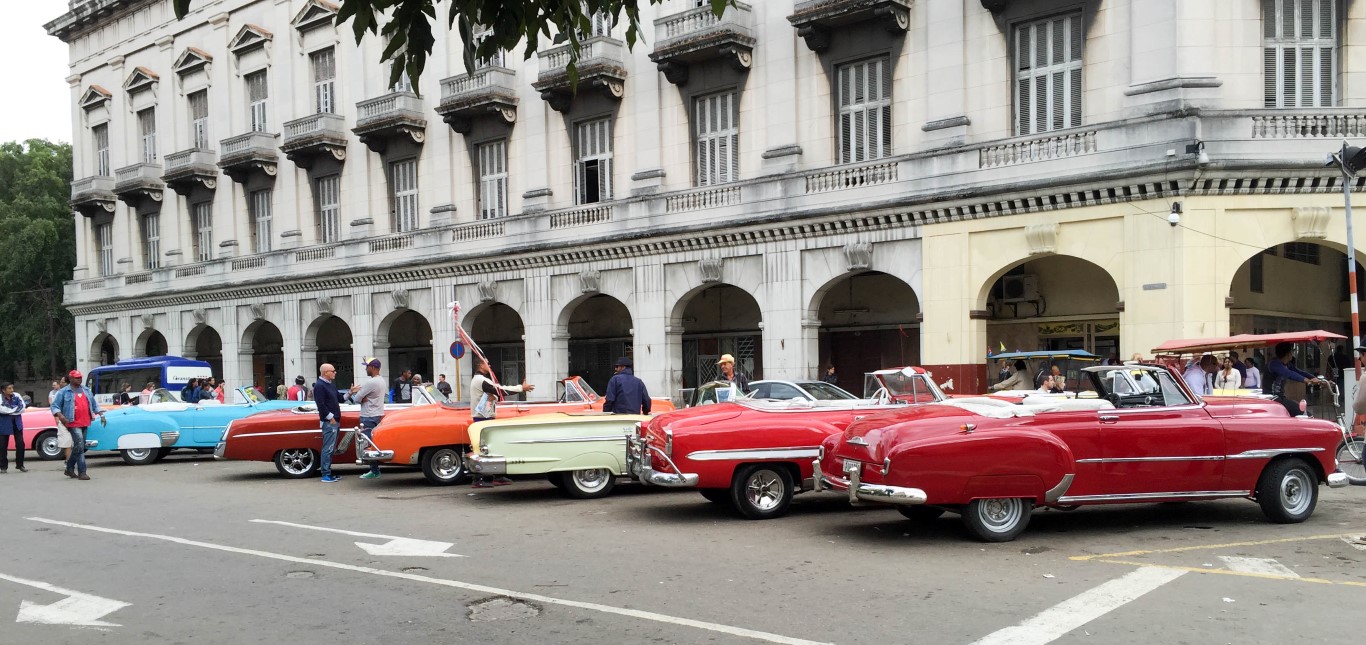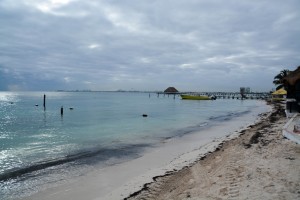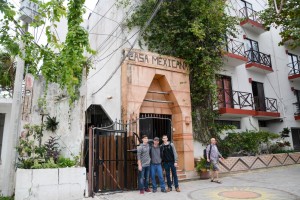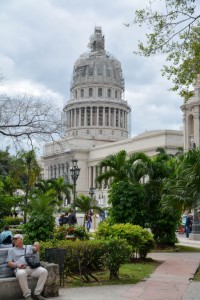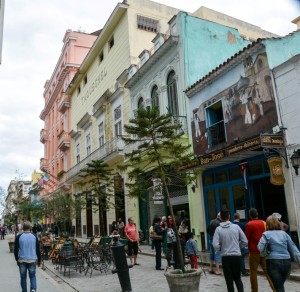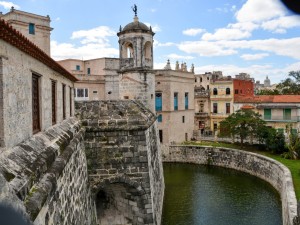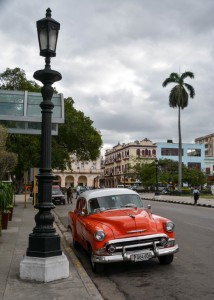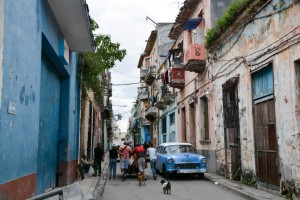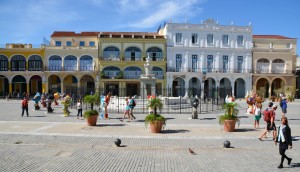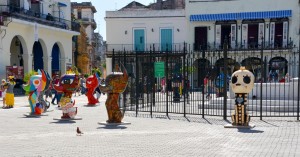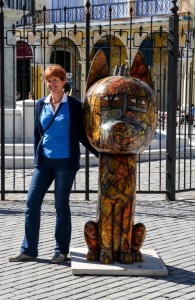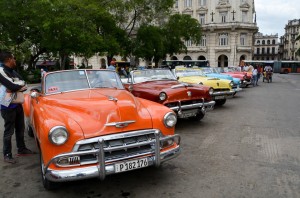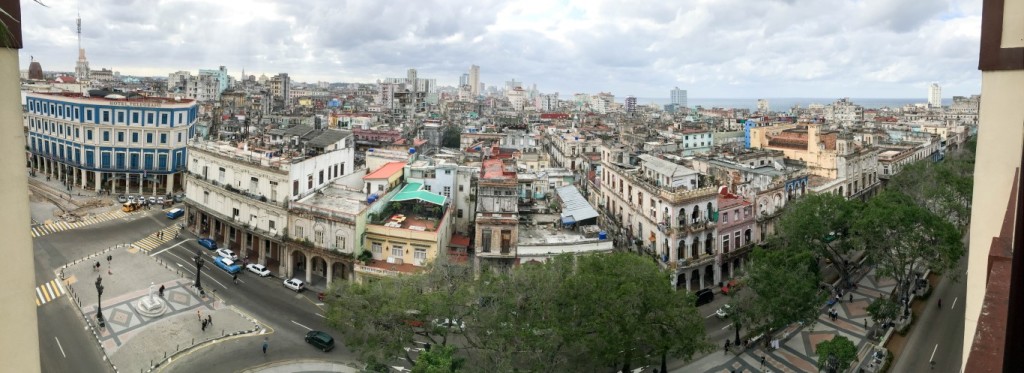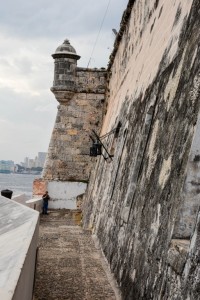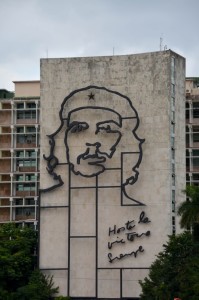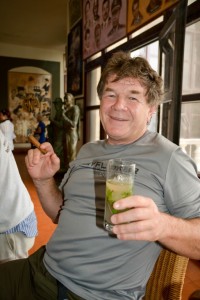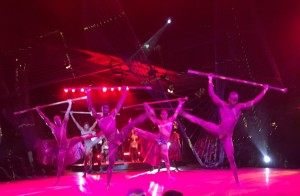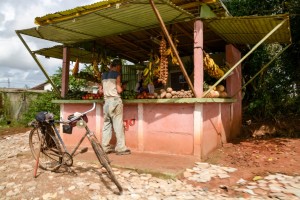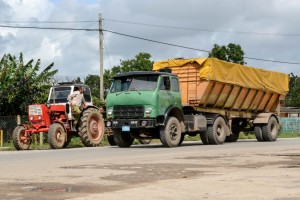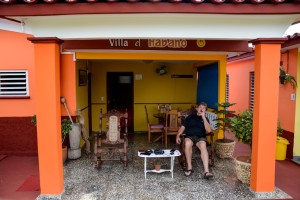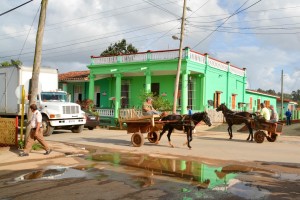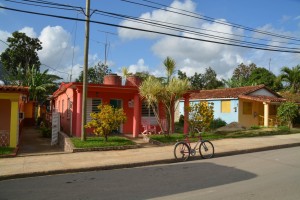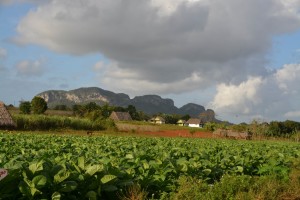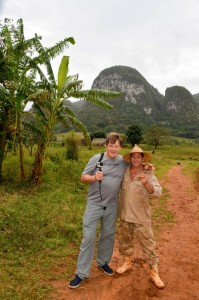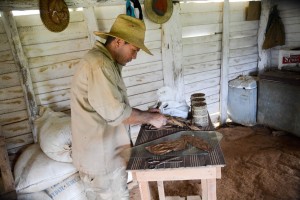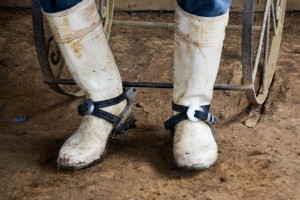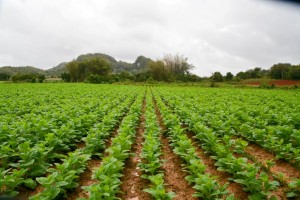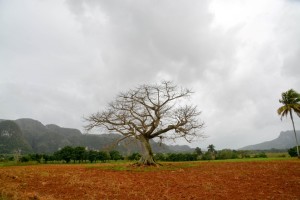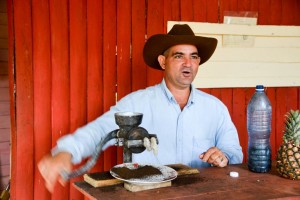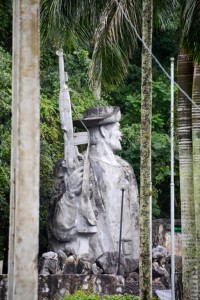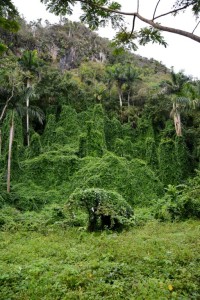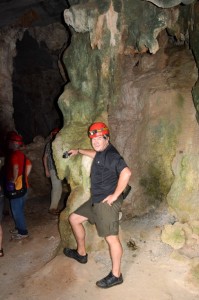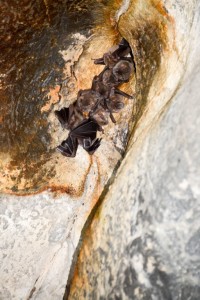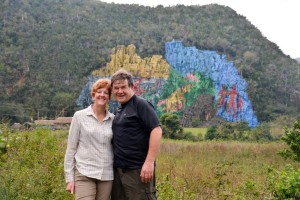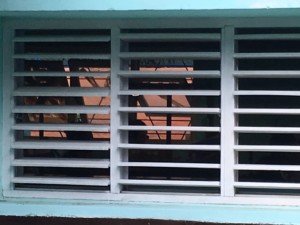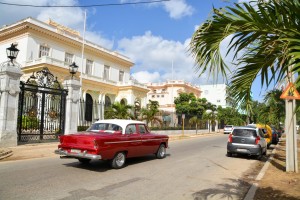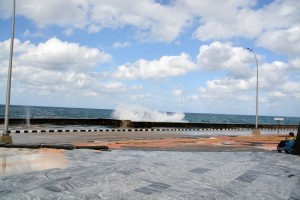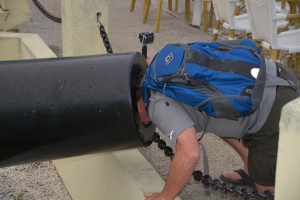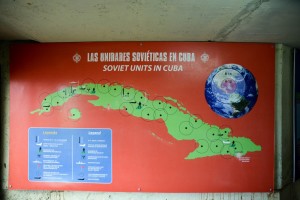Roger: Saturday 23 January
A stroll out the back of the hotel to the beach confirmed that the pictures on Hotel.com had been doctored up considerably. Sitting by the pool were three blokes from up near Chicago. Ben, Chris and Andrew had just arrived and told they couldn’t check in until 2pm. We left their bags at reception and took a wander up the road. This part of town was probably pretty flash when built at least 50 years ago but nothing much has been done since.
The trip to the airport revealed more run-down buildings.
I met Sylvia at the airport. She had got her visa in Cancun at the check in queue for USD25 – in about 3 minutes. I had got mine in NZ by applying to the consulate and sending passport and $80 – it took a couple of weeks! Aboard the late Russian Tupelov 204 we made the 1hr 20 flight to Cuba. Customs and immigration was a walk through.
Cash is king in Cuba. We headed to the ATM on the second floor at the airport. My Air NZ smart Mastercard was not too smart – it would not work. We changed some Euros at the money exchange. A 25 local taxi ride took us to the Hotel Parque Centrale.
After dinner at the rather unique hotel restaurant we adjourned to the lobby bar and the pleasant odour of cigars. The man on the cigar trolley lit me, with great finesse, a Cuban. We joined a lovely English couple, Dan and Amy from Stratford for a port and a good yarn.
A little about Cuban history: Columbus rocked up here in 1492. The place had been inhabited for 4000 years by inhabitants having come from South America. The Spanish built a fort in 1503. Morgan and Drake, pirates raided through the 1500’s causing the Spanish to send an armada and fortify the place. The English in 1762 ruled for eleven months then exchanged it for Florida with the Spanish. In the 1860’s the Independence movement started. Finally in 1902 with the help of the US it became independent.
In the 1950’s Castro and his merry men started the revolution. After being jailed and let out a few times including a stint in Mexico he finally took over in 1959. The US tried invading at the Bay of Pigs with ten thousand men but they were defeated in less than seventy two hours. In October 1962 the Russian missile crisis nearly put the world into atomic war, only avoided by President JF Kennedy’s good management. In 2008 after three successive hurricanes they started western reformation. In 2015 Obama finally recognised Cuba.
Sylvia: Sunday 24 January
We had a lazy morning, feeling the effects of the 3-hour time difference. We had breakfast in the hotel before heading out to explore the old part of Havana. Hotel Parque Centrale is right on the Central Park (funny that) in the heart of Old Havana. There are always loads of old style cars parked outside waiting to take people around the city but today we opted to walk, wandering down Obispo towards the bay, marvelling at the thickness of the old buildings, the variety of colours, the general cleanliness (relative to other parts of Central America anyway), and the friendliness of the locals. Despite being warned about touts and hassles, we found people would ask once if we wanted a taxi/restaurant etc and after a polite “no thank you” would smile and leave us alone. I feel as safe here, if not safer, than anywhere else I have been, and certainly safer than I do in downtown Auckland, Melbourne or Sydney.
We took it pretty easy, strolling down to the Main Square where we bought a second-hand guide book from one of the many stalls, and then to the Museum Castle of the Royal Force. From here we had great views over the bay to the large fortresses and giant statue of Jesus. The moated castle was built in the 1600’s and set the standard by which all other forts in the area were designed.
There are many amazing buildings and lots of lovely little squares and plazas here with some pretty incredible street art as well. Much of the old city is pedestrian only with many of the bollards actually old canons and cannonballs. We spent a bit of time wandering around the San Jose Arts and Crafts Fair which had loads of different paintings and photographs as well as other art and crafts.
Eventually we headed back to the hotel and up to the bar on the top deck for gin and tonics and a cigar with a fantastic view over the city. The requisite band was fantastic – the flute in particular was impressive – enough so that we actually purchased the CD. Then down to the main bar for more drinks and cigars… the smell of cigar smoke is quite pervasive – people start smoking them early in the morning and even women seem to smoke them – they certainly haven’t picked up on the no smoking rules that seem to have been adopted by most of the rest of the world.
We had a delicious dinner in the hotel’s steak restaurant – perfectly cooked steak, great wine and chocolate soufflé. So much for not being able to get good food in Cuba!
Roger: Monday 25 January
A stroll to the old square revealed a bunch of cartoon style statues surrounding a water statue. In the corner of the square is a naked woman riding a rooster cast in bronze. The square is surrounded by European-style buildings several hundred years old in good condition with wrought iron railings. We went to check out a couple of museums to be told closed Monday.
Coming across a very old fort with a now empty moat we strolled around the front to take a look inside and discovered it was the police station.
The museum of the revolution was open – a grand building with a dome tower. The exhibits were mainly photos taking one through all the revolution attempts. It is rather self-centred and badly put together. The building next door contains the boat Castro came from Mexico on surrounded by tanks, planes and other armaments but is closed just now.
The rest of the day was spent strolling the streets visiting the odd bar. We took a taxi to look at a couple of Casa’s for AJ, Cam and I to stay in next week. The guy was really helpful in getting us sorted.
A drink on the roof top bar at the hotel was followed by a bar hop including the El Floridita Bar (Ernest Hemmingway’s watering hole) to the Dona Eutimia restaurant by the Cathedral Square. We can highly recommend this place; with only eight tables it has amazing food and is really cheap. Bookings are essential.
Sylvia: Tuesday 26 January
We slept late this morning and just made it to breakfast before the restaurant closed. It is a beautiful sunny day and after giving up on the hotel internet we headed back to the internet café we had found yesterday to check up on a few things back home then back to the Tobacco Museum that was closed yesterday. Someone had obviously taken a bit of care with collecting a lot of tobacco-related paraphernalia but overall not a particularly inspiring place.
Next we wandered back to Old Square and visited the Camera Obscura. This is on the rooftop of a tall building on the corner of the square. There are great views over Havana from the rooftop but the really interesting part came from the “camera” itself, one of only 6 in the world with the rest in Europe. The “camera” is basically a large periscope that reflects a live image onto a concave screen inside the room. The guide was fantastic and used the “camera” to point out the different sites of Havana.
It was finally time to try out one of the old cars After a bit of haggling, Roger settled on an old 1959 Dodge convertible – apparently the only one in Cuba with its original motor. We agreed on a two-hour tour of the city and cruised off, music blaring and Roger videoing… Our driver, Yulieski was great, pointing out the different sites. We first headed under the tunnel under the bay to some of the forts across the other side, stopping also at the cigar exhibition where the Guinness world record 81m cigar is displayed curling around the ceiling in a Perspex tube. Back under the tunnel again we drove into the ‘newer’ part of town to see the Jose Marti Revolution Square with its tall tower and large iron work etchings of Che Guevara and one of the other revolutionary soldiers.
Next stop was the Nacional de Cuba Hotel, which prior to the revolution was a large casino and now boasts the hall of history with photos of many famous people. Yulieski assured us they serve the best mojitos and pina coladas in town so of course Roger had to have the typical Cuban mojito and cohiba cigar, while Yulieski and I each settled for a natural (no rum) pina colada – very tasty.
In the evening we headed first to Sloppy Joes, the original, established in the early 1900’s and still decorated in the same way. There we had drinks and burgers among photos of various guests both past and present. After another drink and a cigar (for Roger) back in the hotel bar we caught a taxi to the Tropicana show, under the stars out in the suburbs about 20 minutes from the city centre. The show was impressive with amazing costuming and about 50 dancers and singers as well as a full orchestra. There was even a special guest appearance from some outstanding opera singers: three tenors and four sopranos, one of whom was male! The first time I have ever seen a male soprano. Our taxi driver had waited for us and returned us to the Parque Centrale at about 1am.
Roger: Wednesday 27 January
At 0815 I was waiting in the already formed queue at about number 15 outside the local bank. About 0845 I finally made it to the door to be told by a nice banker with good English that “it’s the day we pay the old people until 1030”. I was sent to the money exchange four blocks down the road. They would not take my Air NZ Smart Mastercard (so much for smart) so I headed back to the bank and eventually got the arrogant security guard to get the man with good English.
Back in the queue and when they ran out of old people I got to see a nice chap at the counter, also with good English. Still no luck with the smart card. Luckily my back-up Visa worked or we would have had to go to plan C which I won’t go into. If you’re coming to Cuba bring enough cash to pay for everything in Euros; the USD incurs a 13% charge.
At 1100 our taxi to Vinales turned up. About thirty minutes later we were clear of the thick petrol and diesel fumes spewed out by the pre-1960 cars and trucks which seem to make up at least a third of the traffic.
The highway is a three, then two lane highway. About 70kms into the journey, through what is scrubby farm land, we stop at a thatched-roof diner. The guy behind the counter in bow tie and waist coat (seems to be a theme here) makes us a coffee and soon we are on the road again.
We pass many trotting horses and two wheeled carts along the highway. Under overbridges people sit in the shade, I think waiting for a bus. The further west we go the more cultivation we see. Houses are colourful often sited alongside tall thatched tobacco barns.
We reach the valley of Vinales and stop at a viewing spot. The view over the valley is spectacular with the limestone karst mountains (mogotes) in the background. There is a guy there with a big bull all saddled up ready to go. Yes you got it! I couldn’t resist. Short as the ride was it was amusing.
Down the hill and through the town and we arrived at Villa El Habano (http://elhabano.alwaysdata.net). This is a stunning place with rocking chairs on the courtyard outside our room. Sylvia is really good at finding us neat places to stay through researching trip adviser and other reviews.
After a beer and a cigar we took a stroll into town. The place is well kept with nearly every house being painted a different bright colour. We wandered around various streets one leading out into the paddocks. The people are really friendly smiling and waving as one takes movies or pictures. Old cars, trucks, horses, bikes and tractors make their way up and down the streets. Just about every second house is a casa. There are 800 casas (private homes licensed to rent out rooms for accommodation) in Vinales, each with between one and five rooms. Only the pictures can really describe and I hope give you a feel for the place.
Arriving back at our Villa some two and a half hours later we relaxed in the rocking chairs until a superb dinner was served on the porch. Chicken for Sylvia and Pargo fish for me accompanied by rice beans and salad. One can see how this place gets such great reviews. 25 locals a night for the room, dinner 8 to 10 locals, beer and wine very cheap and they have better internet than we were able to get in Havana!
Yuray, the owner, gave us a bit of rundown on how it all works here. Back in the 90’s they had little in the way of food, clothing etc. and intermittent electricity. Reforms have now meant that he owns his Villa (Casa) and pays 25 locals in tax on each room per month and a further 10% on his total turnover. He seems very happy with this having expanded from one to five rooms over the past few years.
A little about tobacco: Columbus when he rocked up here found people puffing on cohiba (tobacco) through tabago’s (pipes). This act was called “sikar”. He must have had a few puffs and enjoyed it as he took a bunch of the stuff home with him. Soon the whole of Europe was puffing away with tobacco being grown commercially in Cuba from the 16th century.
Sylvia: Thursday 28 January
This morning we were up much earlier. A delicious breakfast was provided for 4 locals each including omelette, toast, fruit, flan, ham, cheese, juice, coffee etc. At 8:30am our guide for the morning Yubier, from www.horseridinginvinales.com arrived to take us into the national park. Roger mounted Chocolate and I was on Lucerno. We headed into the park for four hours at a sedate walk. Chocolate lead the way and while extremely well-broken in and used to the trek you could actually get the horses to obey instructions from the reins.
Our first stop was a tobacco farm. In the National Park area no mechanisation is allowed so everything is done manually. In this area the main crop is black tobacco but other crops like manioc, rice, maize, tomatoes, pimentos, coffee, cocoa and sweet potatoes are also grown. The farmers must sell 90% of the tobacco to the cigar factories but can keep 10% for their own use and to sell to tourists.
From a tiny, dust-particle sized seed, the plants reach 1.2m in about three months. They are then dried for a minimum of four months and are then fermented with fruits, cinnamon etc for 45 days. In total it takes twelve months to go from seed to cigar (I know the maths doesn’t quite work but that is what I gleaned between his broken English and my broken Spanish.) Only tobacco grown in a very few parts of Cuba is used for habano cigars (the best apparently) – including this area. Leaves from the same plants are used for different brands of cigars. Cohiba cigars (apparently the best of the best) are made only using the three top leaves, then the next leaves are used for Montechristo, down to the leaves for Patageros and at the bottom for cigarettes only. Cigarettes will also often contain yellow tobacco as well as black. The Romeo y Juliettta’s that Roger favours are from a mixture of the upper and middle leaves. Apparently Fidel Castro used to favour Cohibas and Che Guevara Montechristos.
Once the leaves have been dried and fermented the cigars are rolled – not on the thighs of Cuban women much to Roger’s disappointment. Our guide demonstrated how the main vein from the leaf is stripped – apparently it contains 70% of the nicotine and is discarded for cigars but left in cigarettes. He then rolled a perfect cigar, retaining the best leaf for the cover – all in less than 3 minutes. Here at the tobacco farm you can buy cigars that are made from the same tobacco as the big brands for a fraction of the cost. Roger was very impressed with the one he had been given on arrival and proceeded to purchase 25 – all bundled together and wrapped in a palm leaf to keep them safe. Apparently they will keep that way for 2-3 years.
Back on the horses we headed to our next stop, passing plenty of other tobacco farms, pigs, chickens, cows, horses and other crops growing. This area is stunning with large, flat-topped limestone mountains or mogotes dominating the landscape. In one area we saw people planting out tobacco plants and in another the ground was being prepared by a guy being pulled around on a farrow-type thing behind two yoked together oxen. Eventually we arrived at an open-air café with fantastic views over the surrounding area. This place brewed and sold locally grown coffee.
After about 4-hours we arrived back where we started. It had started to rain and Yubier had been fantastic. He gave me his raincoat to keep the camera dry (I just needed to keep his cigarettes, wallet and cell-phone in the pockets) so I fared much better than Roger who was quite sodden by the time we got back.
Yuray, our host at Villa El Habano then arranged a driver, in a 1954 Plymouth with a 4 cylinder Russian Volga motor (it does 7 kms/litre here in the mountains and 9kms/litre on the motorway) to take us to the Caverna Santo Tomas, a huge seven-level cave that runs for 46kms. They take tourists through level 6 and 7 – helmeted up and with head-torches. With all the rain the ground was pretty slippery underfoot. We were with a group of about 20 and a couple of the older women struggled a bit, slipping and falling a few times. The cave itself is impressive and it was really enjoyable to be able to walk through one with no footpaths, railings or other safety features – just a natural cave with only a couple of wooden ladders to help with the steeper sections. It has loads of stalactites and stalacmites and we also saw some vampire bats, a crab and a frog. Apparently there are also scorpions, tarantulas and snakes, although the latter, large boa constrictors, are found primarily in the subterranean rivers – thankfully!
On the way back to our casa we stopped to take pictures of a large mural painted directly on the mountain back in the 1960’s.
After a fairly active day it was nice to relax outside our casa, catching up on emails, blog etc. Roger is definitely enjoying the cigars he purchased; apparently they are the best he has ever had. We enjoyed another delicious meal, prepared by our hosts before calling it a day.
Roger: Friday 29 January
After another great breakfast at Villa El Habano we headed to Pinar Del Rio. This place is a little more city like being the capital of the region.
Patriotism is alive and will in Cuba, particularly in this region with lots of statues and signs about the revolution; Che Guevara features dominantly on many of them. “While one guerrilla is alive there will still be a revolution”.
Our taxi waited while we toured the local cigar factory. About 40 workers roll around 150 cigars each a day. Sitting a benches in rows of four each person completed the whole process. The initial roll is placed in a plastic mould with a dozen others. The trays, up to ten at a time, are then pressed in an old manual wind down press. The trays then go down to a tester who puts each cigar in a machine to test the air flow (if they are rolled too tight they are too hard to smoke, too soft and they burn too fast). Then it’s back to the roller who puts the outer skin on. They do all this while bantering and laughing as a bunch of tourists lean over the rail watching. There are strictly no photographs allowed.
The ride back to Havana was a bouncy one as like most cars here the yellow cabs suspension needed some attention. Arriving at Hotel Capri at just after 1pm we were told come back at four (rooms not ready).
We took a stroll down to and along the Malecon. Surf was breaking over the wall onto the road as we viewed the odd statue. This area (the new city) does not have the character and charm of the old part of town. There are a few well maintained buildings which are mainly Embassy’s. The US one being the largest most modern and most secure.
We ended up at the National Hotel for a drink and a cigar. A stroll through the garden afterwards revealed a couple of 280mm canons used to engage the USS Montgomery at 9000 Yards in 1898 during one of many wars with the US. Interestingly it didn’t state if any hits were made!
Just below the canons are a maze of tunnels with a display on the October 1962 nuke missile crisis. A large number of Russian military were deployed on the island including ground to air missile batteries, fighter aircraft and much more. It was a U2 spy plane that spotted nukes being unloaded from a ship that nearly set off a nuclear world war, with R12 and R14 mobile nuclear missiles located in three different places. With the R12 ranging most of the US East coast and the R14 the whole of the US things got a little tense. Castro wanted the US out of Guantanamo Bay. In the end the US took its nukes out of Turkey and Russia took theirs home.
Arriving back at Hotel Capri we were told there was a problem with two floors. They sent us off back to the Hotel National with a voucher.
After checking in we strolled along the Malecon to the La Abadia restaurant, highly rated on the net. Service was poor and the pork tough and cold. Cheap as it was, we rated it poorly, especially with the constant roar of traffic from the Malecon.
